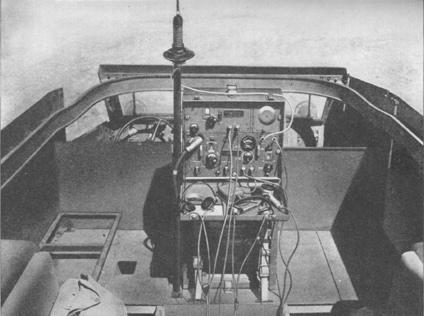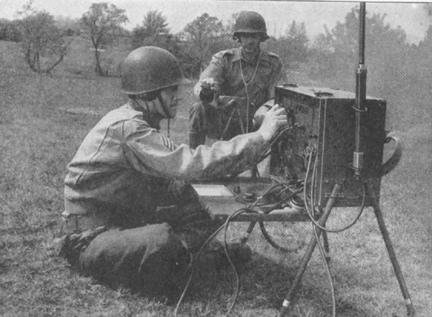The Mississippi Historical Radio and Broadcasting Society
News Letter
Our regular club meeting was held on May 8, 1994. Attendance is starting to rise with this new time and day. Our next meeting will be June 12, 1994 at 3:00PM. See you there!
Bill Gerk is working on a "mini-show" to be held down in the Hattiesburg area later this summer. There seems to be a lot of interest. Planned so far is a mini-museum and swap meet. If you have any suggestions - or want to help contact Bill at 268-6059.
Club projects are continuing along nicely. The "Radio in Uniform" project has been getting a lot of attention since the 50th anniversary of D-Day etc. is upon us. We have 2 radios that are definitely D-Day vintage, and one that could be. The BC-348, which saw service all during WWII could have been in support of Normandy, but we just don't have any details - we are still trying to trace it via serial number and contract numbers. The RAO-6 we know was put in service in April 1944, on a contract that was specifically for the D-Day "ramp-up". The RAO series was designed as "super-snoop" radios; with one of the specifications calling for radiation from the local oscillator can be no more than 400 picoWatt (that's .8 microvolts on 600 Ohm load) measured at the antenna terminals. Seems that U.S. Navy had figured out that it could detect other ships etc. by the radiation of the signal generated by receivers' local oscillators. Since they could detect an enemy ship that way (and knowing what it was listening too!) it stood to reason that our ships were vulnerable to the enemy's ears as well... So the Navy ordered the RAO series with extraordinary specifications for shielding. We know from history the Germans never heard them coming... The RAO's are powered by AC or from batteries: 6V @3.5A & 180V @ 60ma.
The other radio - the BC-654; also known as the SCR-284A Radio Set; is our hottest project. The reputation of the BC-654 is long and proud. A BC-654 mounted in an M2 Half Track  |
The BC-654 is a receiver / transmitter which covers 3800KC to 5800KC, is rated at 17Watts CW, 5Watts AM Phone - although 25W CW and 11W Phone are typical. The Radio Set comes in three basic configurations - Field Radio Set, Vehicular Radio Set and Command Radio Set. The first two were used during WWII; all three during Korea. In all configurations, the receiver / transmitter are identical - the differences come in how the unit is installed and powered. As a field radio, the unit sets on four legs, the receiver powered by a battery (BA-43) and the transmitter by a hand cranked generator. The set packed up into three 55 pound back-packs that the radioman and two assistants would carry. Once in operation, the radioman operated the set, while the two assistants took turns cranking the generator and standing guard. As a vehicular set (as pictured), the set sits on a large stand which also holds a 6/12V dynamotor (PE-103), and the radio uses a vibrator supply (PE-104). As a command set, the unit is usually set on a table, and powered by a two cycle 3600RPM 1 horse gas generator. The BC-654 first saw combat in Africa during operation Torch November 8, 1942. The BC-654 was the first radio set to establish communications from the beach to the Fleet, and was used to coordinate Naval gunfire, and Beach Nets. BC-654 Field operation with GN-45 Hand Crank Generator  |
The Signal Corps intention was to replace the BC-654 with the BC-1306 by Normandy. There were some snags in the production of the BC-1306, so starting with serial number 54,100 (and a date of around August 1943), some 50,000+ BC-654's were produced and delivered in support of Operation Overlord. There is a story that one of the first half-tracks to reach the beach was disabled so was used as a radio relay to the Fleet to coordinate the landing and Naval Gunfire - if this story could be verified, it may well be that the BC-654 was the first radio on the beach at Normandy as well - but things were such chaos that day, no one seems to know for sure -there certainly wasn't time to take inventory! So we will probably never know for sure. After the War, (and a total of some 150,000 units) many BC-654s were sold as surplus to HAMs and others for $15 each - a long way from the $874 each the government paid. Along came Korea. By this time the BC-1306, which was difficult to build, had been replaced by the AN/GRC-9 set. However, there weren't enough, and the government bought up a bunch of BC-654's out of surplus, and put them into service in Korea. The main power source for the GRC-9 is a PE-162 gas generator. The Signal Corps modified one issue of the PE-162(B) and added a power connector for the SCR-284 (BC-654). After that "police" action, the remaining BC-654's once again hit the surplus market. That brings us to our BC-654 - serial number 56089, manufactured in August, 1943. Whether it ever saw combat is doubtful - this unit looks as it did the day it was made. Complete with all spares and most of it's accessories, this radio is ready for service. The manual, TM 11-275 dated 24 January, 1944, with supplement 1 of February 11, 1944 and supplement 2 of 6 April, 1944 (covering S/N 54,100 and up) shows the final configuration of the BC-654 as it went into Normandy. The list of items needed to complete the set is fairly short:
* FM-41-A Vehicular mounting frame (under construction).
- Remote Control unit RM-29
- Generator GN-45 w/ case CS-41
- Mast Bag BG-58, canvas
- Leg LG-2-A (for generator)
- 2 ea Leg LG-3 (for generator)
- 4 ea Legs LG 13-A (for field radio)
- Insulator IN-106-A (on order)
- Mast Section MS-54
- Battery BA-43 (dead OK)
We have everything else - including the other 7 sections of antenna, the cranks for the generator, etc. As noted above, Farrar Grisham is building the vehicular frame, and Fair Radio has the insulator - which is on it's way.
The only other thing we need - is people! We are trying to find radio operators who used any these three radios during WWII and/or Korea. If you know of anyone, please get us their names and contact information so we can get in touch with them. The Meridian Star and WTOK TV are both interested in doing a story on this - and are going to help us search for Veteran Radiomen (and or WAC's - there were many Women Army Corp radio operators as well!!!). So ask your neighbors, friends, relatives, people at church, clubs and anyone you meet that MIGHT be old enough - We certainly would like to meet someone who could tell us more about these radios; and they would probably enjoy seeing some equipment they haven't seen in 40 or 50 years.
A long term goal is to establish a permanent exhibit of "Radios in Uniform" as part of our museum. The Corbin has threatened to deliver a 1/2 track --- I just want to know who's going to buy the gas??!!!
Next time well look a little closer at how each radio served in the war effort, and hopefully report on our project's progress.
Until next time!
Happy Collecting!
The Mississippi Historical Radio and Broadcasting Society Newsletter is published monthly by:
The Mississippi Historical Radio and Broadcasting Society
2412 C Street
Meridian, MS 39301
601 693-5958
© 1994, The Mississippi Historical Radio and Broadcasting Society.
Back to Archive Page


